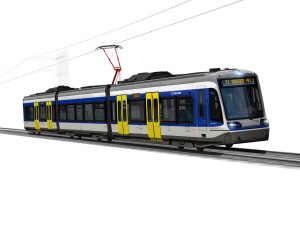 MÁV-Start ordered 4 additional CityLink bidirectional tram-trains from Stadler, exercising the option as part of a contract for de supply of 8 vehicles signed in 2017. First 8 units are expected to enter commercial service by the autumn of 2021, while the optional 4 units by the summer of 2022.
MÁV-Start ordered 4 additional CityLink bidirectional tram-trains from Stadler, exercising the option as part of a contract for de supply of 8 vehicles signed in 2017. First 8 units are expected to enter commercial service by the autumn of 2021, while the optional 4 units by the summer of 2022.
The tram-trains will serve the first tram-train system in Hungary providing transport connection between the cities of Szeged and Hódmezővásárhely.
The new tram-trains are able to operate in electric mode under 600 V DC overhead on the tram networks in Szeged and Hódmezővásárhely, and in diesel mode on the railway line connecting both cities. They feature two low-emissions diesel power packs rated at 390 kW. They are also able to negotiate narrow curves of 22 m radius providing the benefit of being used in existing curved streets of city centers.
Easy access for different platforms types, without modifying the current height of the platforms, is also ensured by the doors located at different heights and the use of different type of sliding ramps.
The fully accessible vehicles are 37.2 metre-long and 2.65 metre-wide providing a capacity for 220 passengers with 92 seats. The vehicles are low-floor throughout and barrier-free. Spacious interior with a high number of seats and four multi-purpose places for persons of limited mobility such as wheelchair users and parents with prams, full HVAC, CCTV and PIS systems are all features that will optimize the passenger travel experience.
The tram-trains are designed according to the latest safety standards.
The new bidirectional vehicles, designed and manufactured by Stadler Valencia, will connect the tram network of the two cities without the need of transshipment activities. The objective of the first tram-train project in Hungary is to provide a high-quality public transport system for passengers commuting every day between the two cities.
Under the base contract, the first eight bidirectional tram-trains would be able to serve a timetable with a 20-minute vehicle frequency, while with the additional 4 units the frequency can be reduced to only 15 minutes.
Share on:



